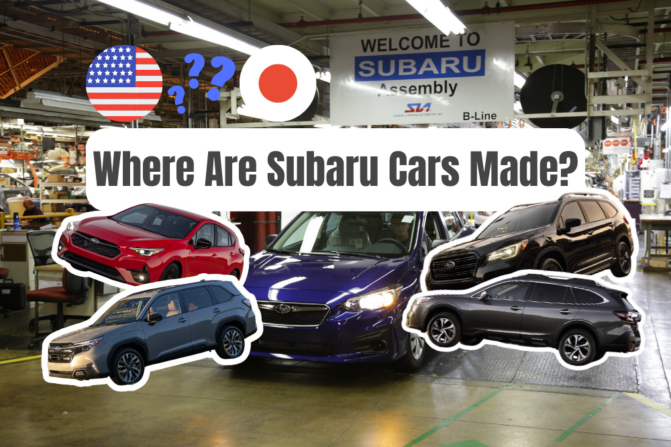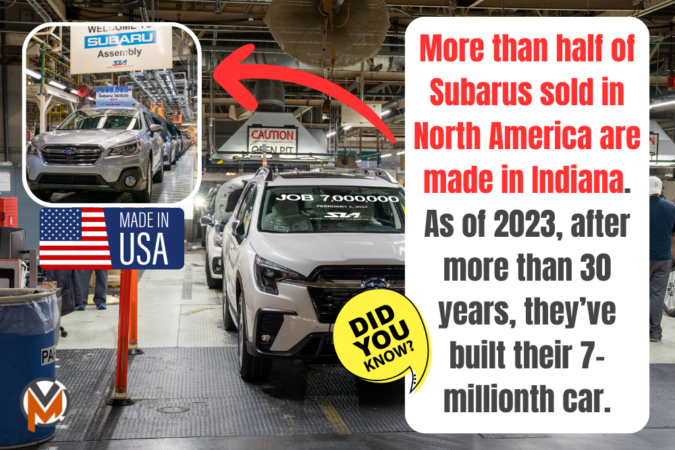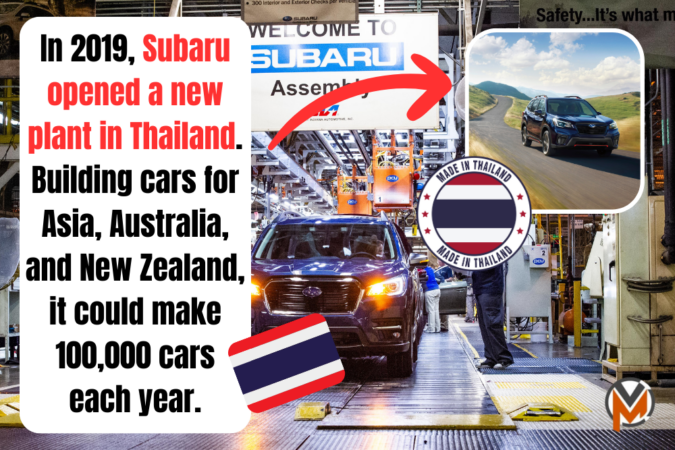For those still wondering about where Subarus are made, they’re mainly manufactured in 5 locations – 4 in Japan, and 1 in the United States. While Subaru is a Japanese brand, its only factory outside of Asia is in Lafayette, Indiana, USA. This is also where most Subaru models sold in the North American market are built.
Many folks – including myself – associate Subaru with Japan, and while that still remains true, they have expanded their global production footprint to meet growing demand. Take Subaru’s plant in Indiana, for example, where they’ve been operational since 1989 and now produce models like the Outback, Legacy, Impreza, and Ascent.
On the other hand, the brand’s other 4 factories are in the Gunma Prefecture in Japan. Here, they’re responsible for making everything else, from the Subaru BRZ to the WRX and the Forester. Beyond Japan and the US, Subaru also partners with international manufacturing facilities to supply cars to other markets, like their plant in Thailand, serving the Asia-Pacific market.
In addition to collaborations with supply chains parts across different parts of the globe, your Subaru truly is a worldwide car! So, with that in mind, let’s take a closer look at where Subarus are made, and what role each factory plays:
Where Are Subaru Cars Made?
This is due to the high demand for Subarus here in the United States (and North America, in general). This was initially a joint venture with Isuzu. Speaking more about Subaru’s Indiana plant, they officially started back in the late-80s. The first car made there is the Subaru Legacy, with production starting on September 11, 1989. Now, it’s got over 6,000 employees.
Fun fact: as of 2023, Subaru’s Indiana plant celebrated the 7-millionth vehicle that rolled off its factory floors. That’s a huge achievement on its own, even more so compared to the production capacity and volume at Subaru’s other four plants in Japan. Currently, most Subaru models sold in the North American market are made at their Indiana plant.
These include the highly popular Impreza, Legacy, Outback, and Ascent models. Then, there’s Subaru’s four other manufacturing plants, all of them located in Japan. All four of which are located in Ōta, Gunma Prefecture, which is then split into four distinct locations. The brand’s Subaru-chō factory is where they build the highly popular Subaru BRZ sports car.
Meanwhile, Subaru’s Yajima plant is where all other Subaru cars, including those sold for overseas markets, are built. Additionally, there’s Subaru’s Otakita plant, which manufactures the brand’s Kei trucks (small commercial pickup trucks, made for Japan). Finally, Subaru’s Oizumi plant manufactures engines and transmissions that are shipped elsewhere, to other locations.
Subaru Manufacturing Plant Locations
Subaru is one of the world’s largest and well-known carmakers, which has since grown in popularity. They’re well-regarded for super-fast rally cars, dependable and tough off-roaders, as well as practical, easygoing daily drivers. It’s truly a brand that makes great cars for everyone, be it car enthusiasts, motorsport fans, or the casual consumer. But, where are Subarus made?
Of course, if you’re in the know or if you’re a gearhead, you think you know the answer already – Japan. They’re a Japanese car brand, and a true icon of JDM car culture. However, as we noted earlier, Subaru doesn’t just manufacture its cars solely in Japan. In fact, they actually have a huge production line here in the good ol’ US-of-A.
If you’re wondering where Subarus are made, the answer is in one of five locations. These five manufacturing facilities, four of which are located in its home country of Japan, while the other is in the US. Specifically, the latter is located in Lafayette, Indiana. If you’ve bought, owned, or looked at any Subaru sold in the US, that Subaru might’ve been made there.
If you buy a Subaru either in Japan or the US, therefore, the chances that you’re driving a locally-produced Subaru are quite high. With that in mind, to get a bit more insight into what each of these five factories does and the role they play in where Subarus are made, here’s a closer look at each one:
Where Subarus Are Made #1 – Subaru-chō Plant
Just a short drive north of Tokyo, the Gunma Prefecture hosts Subaru’s core production facilities. The Subaru-chō location dominates the entire landscape with an impressive 82-acre floor space. Here, enthusiasts will find the birthplace of the Impreza, WRX, XV (known as Crosstrek in the US), Levorg wagon, and even the collaborative models, Subaru BRZ and Toyota GR86.
Where Subarus Are Made #2 – Subaru Yajima Plant
Moving a tad south from Subaru-chō, the Yajima Plant emerges as the production hub for the larger Subaru vehicles. Legacy, Forester, Outback, and even more Imprezas and XVs roll out from this factory. Boasting a workforce of over 3,000 dedicated individuals, it’s no surprise that the plant stands as the heartbeat for Subaru’s mainstream models.
Where Subarus Are Made #3 – Subaru Otakita Plant
Subaru’s roots trace back to Nakajima, an aircraft manufacturer during World War II. The Otakita plant stands as a testament to this history. Though it once churned out Subaru Sambar Kei trucks, it no longer supports vehicle production. Back in the old days, Subaru was incorporated as Fuji Heavy Industries (FHI), a merger of five Japanese industrial giants.
Nowadays, Subaru’s Otakita plant is a major part of Subaru’s supply chain. For example, while Subaru’s Indiana plant assembles Subaru cars for the US and North American markets, the parts to make those cars mostly come from the Otakita plant in Japan. This factory is also known for its large foreign labor force, accounting for more than 30% of employees there.
Where Subarus Are Made #4 – Subaru Oizumi Plant
While smaller in stature than its siblings in Gunma, the Oizumi Plant holds its own with a distinct role, and it plays a crucial role for Subaru. It doesn’t produce vehicles. Rather, it is the heart of Subaru’s power, building engines and transmissions. By centralizing this process, Subaru streamlines its manufacturing, ensuring efficient integration at other plants.
Where Subarus Are Made #5 – Subaru Indiana Plant
Located in Lafayette, Indiana, Subaru of Indiana Automotive is the brand’s primary presence in the U.S. With the capacity to produce over 390,000 vehicles annually (though this threshold is increasing due to high demand), models like the Ascent, Outback, Legacy, and Impreza find their origin here. Spanning 820 acres, this plant also stands out for its eco-friendly initiatives.
Otherwise, Subaru of Indiana Automotive (SIA) is the brand’s only manufacturing plant outside of Asia. Moreover, half of all Subarus sold in North America are made here. While the growing popularity of Subaru cars has forced them to take over the entire factory, in the past, this plant jointly manufactured cars for Isuzu and Toyota. Now, only Subaru vehicles are made there.
In summary, here’s a quick TL;DR cheat sheet table that we’ve prepared, for easier reference:
| Manufacturing Plant | Location | Models Produced | Annual Production (Approx.) |
|---|---|---|---|
| Subaru Indiana Automotive (SIA) | Lafayette, Indiana, USA | Outback, Legacy, Impreza, Ascent | ~400,000 units |
| Subaru-chō Plant | Gunma, Japan | WRX, Crosstrek (XV), Levorg, BRZ, Toyota GR86 | ~300,000 units |
| Yajima Plant | Gunma, Japan | Forester, Legacy (Japan), Impreza (Japan), Outback (Japan) | ~400,000 units |
| Otakita Plant | Gunma, Japan | Kei trucks (historically), parts for the Indiana plant | N/A (Parts & components) |
| Oizumi Plant | Gunma, Japan | Engines and transmissions for all Subaru vehicles | N/A (Powertrain production) |
Other Global Plants And Supply Chain Partners
As far as where Subarus are made, the five aforementioned plants and factories are where Subaru vehicles that we all know and love today are made. However, that’s not to say that 100% of Subaru’s manufacturing capabilities are focused here solely. Subaru actually has a huge footprint elsewhere in the world with manufacturing their cars, past and present.
For example, one of Subaru’s supply chain partners, Tan Chong Motor, a Malaysian-based group, supplies parts for Subaru cars from all across Southeast Asia. In particular, most of this is focused on and around Malaysia, Indonesia, and Thailand. In 2019, Subaru even opened its brand-new production plant in Lat Krabang, Bangkok, Thailand.
This new plant is a joint venture between Subaru and a Hong Kong-based company. Formerly a Mitsubishi-Fuso factory, Subaru’s new Thailand plant will manufacture and supply cars for its markets throughout the rest of Asia, Australia, and New Zealand. Up to four different models could be built at a time, with a current maximum capacity to build up to 100,000 cars.
And then, how can we forget Subaru Tecnica International (STI), the brand’s performance and motorsports division? Back in its heyday, STI partnered with Prodrive, a UK-based company specializing in motorsports, and in particular, rallying. This was where Subaru’s legendary Legacy and Impreza were built and prepped for the World Rally Championship.
How Does Subaru Compare Against Other Japanese Automakers
As we can see thus far, Subaru keeps its manufacturing footprint quite concentrated, relying mostly on Japan and the US for building its cars. On the other hand, some of the other Japanese brands – i.e., Toyota, Honda, Mazda, Nissan, and Mitsubishi – have plants in other parts of the globe. Be it Europe, Asia, or elsewhere to meet worldwide demant.
In fact, Subaru’s US plant in Indiana is its only large-scale overseas production facility, whereas brands like Toyota operate multiple plants across different continents. Granted, it’s worth bearing in mind that Subaru is one of the smaller Japanese automakers. As such, just for fun, let’s take a closer look at how their production strategy differs from the rest:
Toyota
Toyota, Subaru’s largest shareholder, has a global manufacturing presence. Unlike Subaru, which has only two main production hubs (Japan and the US), as we noted earlier, Toyota operates plants in North America, Europe, and Asia. Toyota also produces hybrid and electric vehicles in multiple global facilities.
Honda
Similarly, Honda follows a more diversified production approach than Subaru. You’ll find that they have factories in the U.S., Canada, Mexico, and the UK, allowing Honda to localize production for different markets and regions. Subaru, in contrast, keeps most of its production within Japan, with the US being its only major international hub.
Mazda
Just like Subaru, Mazda maintains a strong manufacturing base centered mainly in Japan. However, you could also find Mazda’s plants located in Mexico and China. While Subaru’s US plant (SIA) primarily serves North America, Mazda’s Mexican plant enables cost-effective production for both North and South American markets.
Nissan
Comparatively, Nissan has one of the most widespread global manufacturing networks among Japanese automakers. Unlike Subaru, Nissan has factories in Japan, the U.S., Mexico, the UK, China, and more. This allows Nissan to localize production and reduce costs in key markets. Meanwhile, Subaru relies on imports for most regions outside North America.
Mitsubishi
Mitsubishi follows a more regionalized strategy, with factories in Japan, Thailand, Indonesia, and the US. They previously even had a plant in Illinois! Compared to Subaru, they have a stronger production presence in Southeast Asia. Here, they focus primarily on compact vehicles and SUVs for emerging markets.




We absolutely love our 2 Subarus. I am a prize-winning novelist, and I hope to visit one of Subaru’s factories “some day” …. …. alas, I don’t think they have a factory near central Virginia.
Subaru makes a truly wonderful car!!!!! We got our two Subarus at the dealerin Orange, Virginia ….